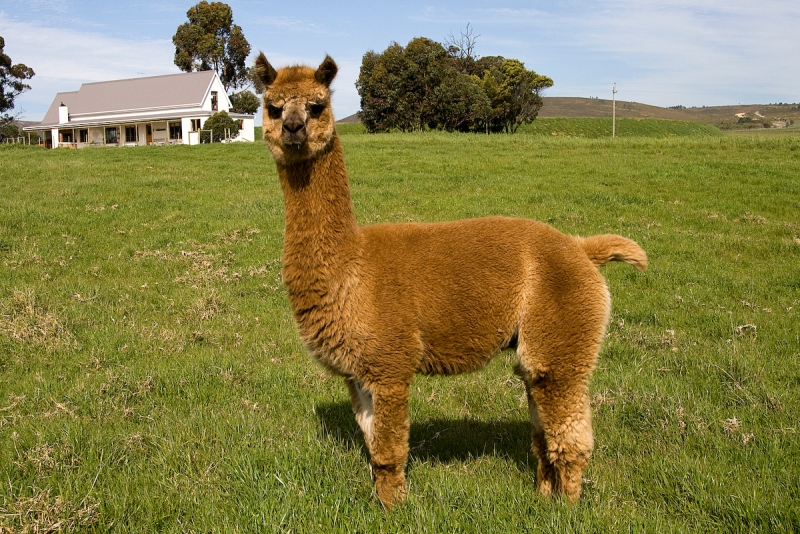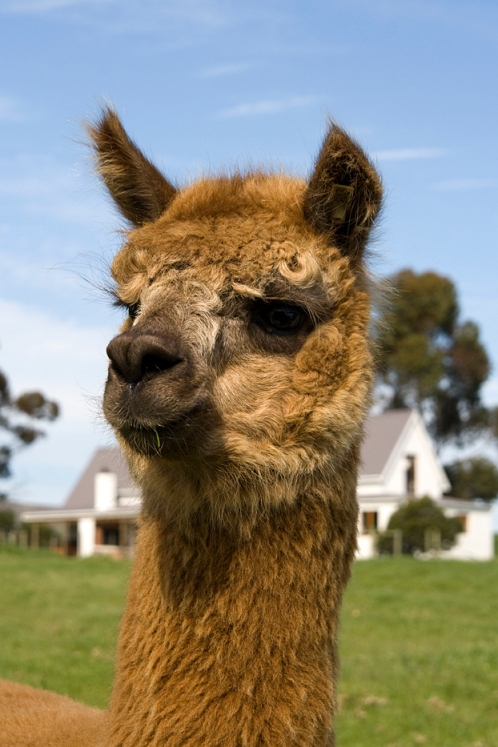Don Carlos, our resident herd guard Alpaca, was imported by SACOYO ALPACAS of South Africa from Chile (South America) for breeding purposes. His somewhat smaller than usual proportions unfortunately denied him that pleasure as taller males are prefered, but all was not lost. Theuns and Valerie, owners of Landmeterskop Farm, fell in love with this handsome guy, and today he guards their herd of Dormer sheep from small predators on this beautiful farm in the Cape Overberg!
Although there are not many alpacas in the Overberg, they have been part of the farming community in South Africa since 2000. Today there are more than 50 registered breeders, and ± 5000 of these beautiful animals grazing on farms and small holdings all over the country. The worldwide population is estimated ± 4 million, with the highest concentration in Peru.
The Inca, high up in the Andes of South America, started domesticating the alpaca ± 6000 years ago. With its long neck and slender legs the alpaca (Vicugna pacos) resembles a small llama, and is a species of South American camelid. [Camelids are members of the biological family Camelidae, the only living family in the suborder Tylopoda (Latin for “padded foot”). Camelids do not have hooves, rather they have two-toed feet with toenails and soft foot pads. Extended family members are: dromedaries, Bactrian camels, llamas, alpacas, vicuñas, and guanacos. Camelids are even-toed ungulates classified in the order Artiodactyla, along with pigs, hippopotami, deer, giraffes, cattle, goats, antelope, and many others.] Alpacas and llamas can successfully cross-breed and the resulting offspring are called huarizo, which are valued for their unique fleece and gentle dispositions.
While the llama was mainly used to carry goods in the mountains, the alpaca was bred for its fibre. They were hailed by the Incas as a “gift from the gods” because of their exquisite fleece – so fine and silky that only royalty was afforded the luxury of wearing clothes made from it. Clothes from alpaca fibre were therefore a sign of great wealth. The ruling king had garments made from Vicunja, the finest and most valuable fleece of all.
There are two types of alpacas – the Huacaya (pronounced wa-ky-ya), like our Don Carlos, and the Suri. 90% of alpacas are huacaya; they have a full, woolly fleece with its fibre growing vertically out of its skin in small bundles with a tight crimped wave which makes the fleece sit vertically off the skin giving it a ‘Teddy Bear’ look. Suri alpacas have a lustrous, silky fibre growing out of the skin in bundles/locks, much like dread locks, without any crimped wave.
A grown alpaca produces enough fleece each year to create several soft, warm scarves; the yield is between 2 to 4kg. They are shorn once a year, without causing injury to the animal. The fleece comes in about 22 basic colours with many hues / variations, i.e black, grey / rose grey, light / dark brown, a variety of fawn and white.
As alpacas are social herd animals that live in family groups consisting of a territorial alpha male, females and their young, they make excellent herd guards for sheep. Like all camelids alpacas are strictly herbivorous, eating hay or grasses, so they feed with the sheep and have similar requirements for supplementation, vaccination and de-worming. The alpaca is a modified ruminant with a three-compartment stomach and converts grass and hay to energy very efficiently, eating less than other farm animals of their size. The herd guard alpacas learn to adopt the sheep as their family and protect them instinctively. They warn the herd about intruders by making sharp, noisy inhalations that sound like a high-pitched bray and may attack smaller predators like jackal and rooikat with their front feet. They can also spit and kick. Sheep, on the other hand, normally would turn around and run away from predators thus making themselves even more vulnerable!
Alpacas are gentle, inquisitive, intelligent and observant. They like having their own space and may not like an unfamiliar alpaca or human getting close, especially from behind. They do not like being grabbed. Some alpacas tolerate being stroked or petted anywhere on their bodies, although many do not like their feet, lower legs, and especially their abdomen touched or handled.
Alpacas make a variety of sounds. When they are in danger, they make a high-pitched, shrieking whine. Some breeds are known to make a “wark” noise when excited. Strange dogs – and even cats – can trigger this reaction. To signal friendly or submissive behavior, alpacas “cluck,” or “click” a sound possibly generated by suction on the soft palate, or possibly in the nasal cavity.
Individuals vary, but most alpacas generally make a humming sound. Hums are often comfort noises, letting the other alpacas know they are present and content. When males fight, they scream a warbling, bird-like cry, presumably intended to terrify the opponent.
Not all alpacas spit, but all are capable of doing so. “Spit” is somewhat euphemistic; occasionally the projectile contains only air and a little saliva, although alpacas commonly bring up acidic stomach contents (generally a green, grassy mix) and project it onto their chosen targets. Spitting is mostly reserved for other alpacas, but an alpaca will occasionally spit at a human.
For alpacas, spitting results in what is called “sour mouth”. Sour mouth is characterized by a loose-hanging lower lip and a gaping mouth. This is caused by the stomach acids and unpleasant taste of the contents as they pass out of the mouth.
An adult alpaca generally is between 81 and 99 cm in height at the withers. They usually weigh between 48 and 84 kg (106 and 185 lbs). Gestation is 11.5 months – one cria is born; twins are extremely rare. Their life-span is between 15 to 20+ years.
Alpacas have only a few dung piles in their pasture, thereby making it easy to clean the paddocks and controlling the spread of parasites. Their dung can be used for fertilisation; the South American Indians use the dung for fuel.
Alpaca meat was once considered a delicacy by Andean inhabitants. Because of the high price commanded by alpaca on the growing North American alpaca market, illegal alpaca smuggling has become a growing problem.




